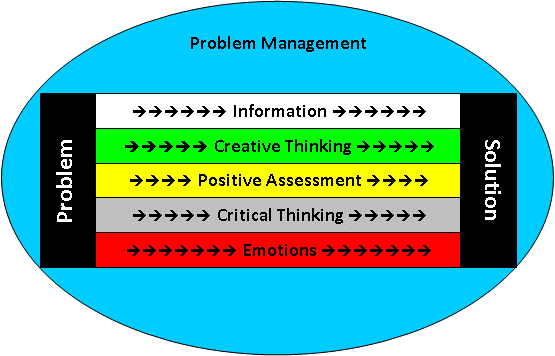
Emotional Thinking
Identify and manage your emotional thinking.

There are many strong emotions that may color your thinking. Here are some emotions you may have encountered: fear, anger, hatred, greed, envy, disgust, inferiority, frustration, resentment, panic, sadness, loneliness, hopelessness, guilt, shame, jealousy, and love.
Identify and list the emotions that you have faced with your situation:
Are you carrying any emotional baggage from previous encounters with this problem? If so, describe those emotions:
Have you already made any snap judgments? If so, describe the emotional content of those decisions:
Every problem has a value base. What are your emotional reactions to those values?
Entering your emotions into the problem-solving process creates quite a dilemma. On one hand, all good decisions include your emotions. On the other, emotional decisions can lead to disaster. To overcome this dilemma, you can combine these two strategies:
To manage your emotional thinking:
Step 1: Separate your thinking. Your mind is not set up to think both logically and emotionally at the same time. As described in Edward de Bono’s book Six Thinking Hats, many times we just try to do too much thinking all at once. To avoid this confusion you need to separate your thinking.
In this adaptation, the thinking process is separated into six parts. The overall organizational process is "problem management". The five other processes are: information, creative thinking, positive assessment, critical thinking, and emotions. These are separate but parallel thinking paths.

Step 2: Temporarily suspend your emotions. The most effective entry point for your emotions is when you're making your final decision. If you enter your emotions during the problem-solving process you may have to deal with several potentially severe consequences:
- Emotions may be substituted for thinking.
- Emotions may color your perceptions.
- Emotions may narrow or channel your perspectives.
- You may forego beneficial opportunities to change the emotional content of the problem itself.
You can avoid all of these negative side-effects if you simply suspend your emotions until you make your final decision.
For some problems, temporarily suspending emotions may seem especially difficult. These are exactly the types of problems where it is absolutely critical.
Disclaimer: People who are suffering through bouts of depression, anxiety, or any other mental health issues. Please seek professional advice.


Source:
Six Thinking Hats, Edward De Bono, Boston: Little, Brown and Company, 1985.
